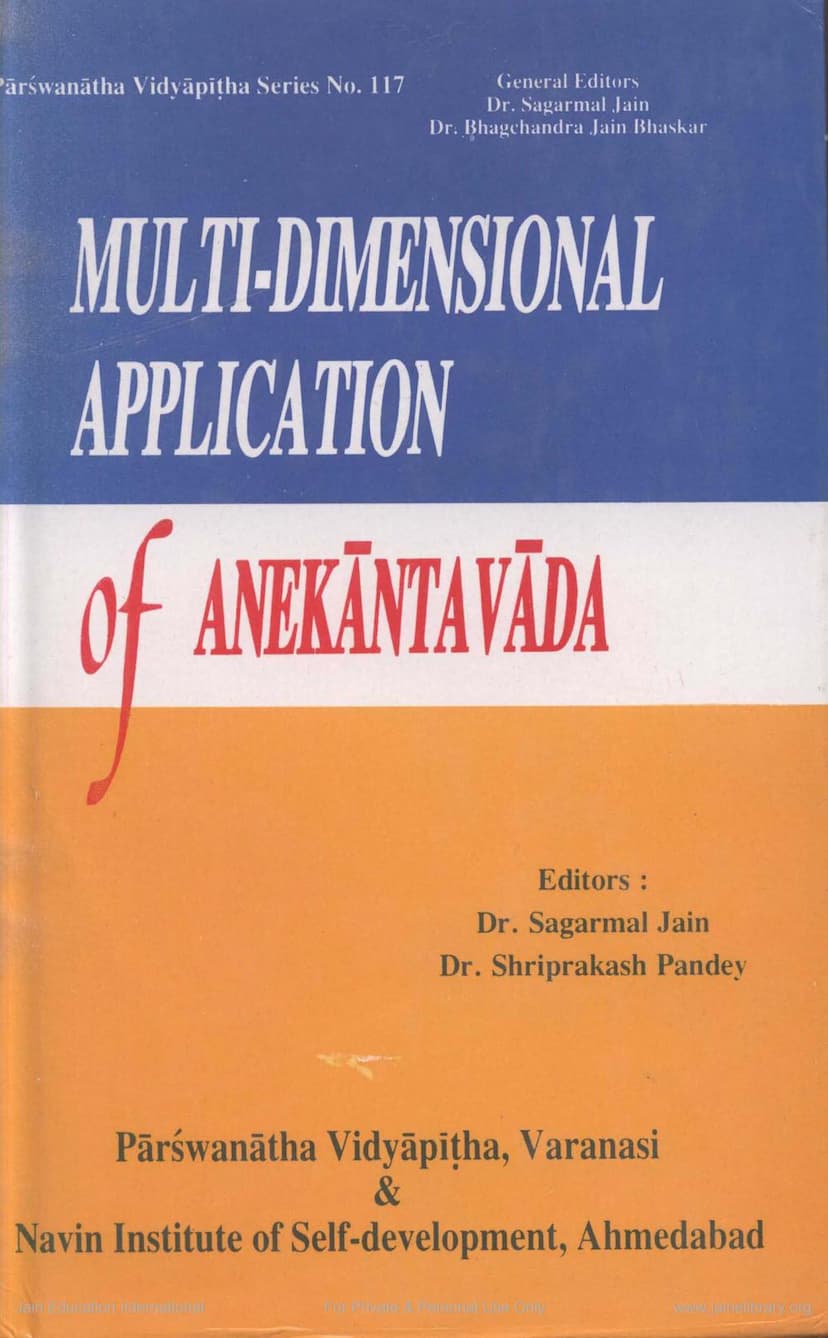Multidimensional Application Of Anekantavada
Added to library: September 2, 2025

Summary
Here's a comprehensive summary of the Jain text "Multidimensional Application of Anekantavada," based on the provided pages:
Book Overview:
- Title: Multidimensional Application of Anekantavada
- Editors: Dr. Sagarmal Jain, Dr. Shriprakash Pandey
- General Editors: Dr. Sagarmal Jain, Dr. Bhagchandra Jain Bhaskar
- Publisher: Parshwanath Vidyapith, Varanasi & Navin Institute of Self-development, Ahmedabad
- Publication Year: 1999
- ISBN: 81-86715-41-X
This book is a compilation of papers presented at a National Seminar on Anekantavada organized by the Navin Institute of Self-'development in 1993, along with selected essays from an essay competition on the same topic by the same institution. The aim is to explore the practical applications of Anekantavada across various dimensions of life.
Core Concept: Anekantavada
Anekantavada, central to Jain philosophy, is presented not merely as a philosophical theory but as a method or approach to understanding reality. Its core purpose is to see, understand, and explain truth in its various dimensions. It is described as a practical path to discovering truth by acknowledging the multifaceted nature of reality.
Key Aspects and Applications of Anekantavada:
-
Nature of Reality:
- Reality is multifaceted and infinite-fold (anantadharmātmakam vastu). It cannot be grasped by a single, absolute viewpoint.
- Anekantavada acknowledges the relativity of knowledge and perception. What appears true from one perspective may not be true from another.
- It advocates for unity in diversity, recognizing that seemingly contradictory attributes can coexist within a single entity based on different perspectives (Nayas).
- The concept of "Syat" (meaning "in a way," "from a certain viewpoint," "relatively") is crucial for expressing this multifaceted nature without falling into absolutism.
- The Saptabhangi (seven-fold predication) is the logical and linguistic tool that elaborates on Anekantavada, allowing for nuanced descriptions of reality by exploring various combinations of affirmation, negation, and indeterminacy.
-
Practical Methodology:
- Rejection of Absolutism: Anekantavada directly opposes "Ekantavada" (one-sided viewpoints) and advocates for a balanced, non-dogmatic approach.
- Intellectual Ahimsa: It promotes intellectual non-violence by encouraging respect for opposing viewpoints and fostering understanding rather than conflict.
- Conflict Resolution: By recognizing the validity of multiple perspectives, Anekantavada provides a framework for resolving disputes in personal, social, political, and international arenas, moving from a "win-lose" to a "win-win" paradigm.
- Synthesis and Harmony: It bridges apparent contradictions by showing how they are complementary aspects of a larger whole, fostering harmony and understanding.
-
Application in Various Disciplines: The book explores the application of Anekantavada in numerous fields:
- Philosophy & Religion: Understanding different philosophical schools, fostering religious tolerance, and promoting interreligious dialogue.
- Psychology: Understanding human personality, managing psychological conflicts, promoting self-development, empathy, and balanced attitudes.
- Jurisprudence: Applying principles of fairness, impartiality, and considering multiple viewpoints in legal processes, mirroring the concept of "due process."
- Management: Effective planning, organizing, leadership, and conflict resolution by understanding diverse employee needs and motivations.
- Politics & Democracy: Fostering political tolerance, understanding opposition views, and building consensus for a stable democracy.
- Environment: Promoting sustainable practices, respecting nature's balance, and avoiding exploitation, recognizing the interconnectedness of all life.
- Social Life: Reducing social divisions, promoting harmony, understanding interpersonal differences, and fostering a sense of community.
- Personal Life: Achieving mental peace, managing desires, practicing self-control, and cultivating equanimity in the face of life's challenges.
- Economics: Balancing individual profit with social welfare, promoting responsible consumption, and finding sustainable economic models.
- Culture: Appreciating cultural diversity, avoiding cultural imperialism, and fostering inter-cultural understanding.
- Journalism: Presenting balanced and objective reporting, acknowledging multiple facets of news stories.
- Creativity: Brainstorming and exploring multiple possibilities.
-
Historical Context: The text traces the roots of this non-absolutist perspective back to Vedic and Upanishadic literature, highlighting its presence in the teachings of Mahavira and Buddha, and its development through various Jainacāryas. It also draws parallels with some Western philosophical concepts.
-
Critiques and Refutations: The book acknowledges critiques of Anekantavada, particularly from Buddhist and Vedantic schools (like Sankara), who saw contradictions or nihilism in its relativistic approach. However, it defends the doctrine by emphasizing that the apparent contradictions arise from a misunderstanding of its context-dependent and relative nature, and that the "syat" prefix is key to its nuanced expression.
-
Modern Relevance: The book strongly advocates for Anekantavada as a necessary philosophy for contemporary times, highlighting its relevance in resolving global conflicts, promoting peace, and fostering integral cosmic development. It suggests that modern scientific discoveries, like the theory of relativity and quantum mechanics, implicitly support the Anekantic view of reality.
Overall Message:
The book argues that Anekantavada is not just an abstract philosophical concept but a practical guide for living. By embracing multiple perspectives, fostering intellectual tolerance, and seeking synthesis, individuals can achieve personal peace, resolve conflicts, and contribute to a more harmonious society and world. It encourages a move from "ekantavada" (one-sidedness) to "anekantavada" (many-sidedness) in thought and action.